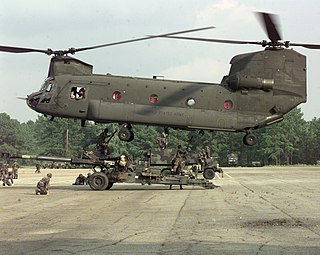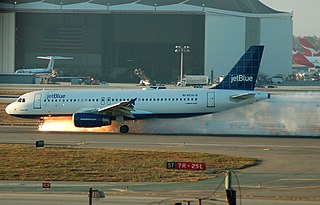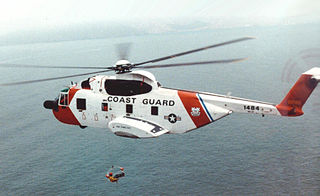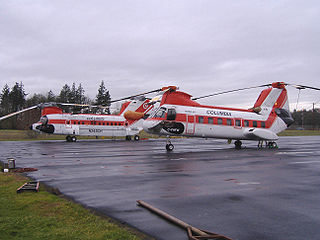
The Boeing Vertol CH-46 Sea Knight is a medium-lift tandem-rotor transport helicopter powered by twin turboshaft engines. It was designed by Vertol and manufactured by Boeing Vertol following Vertol's acquisition by Boeing.

The Kamov Ka-25 is a naval helicopter, developed for the Soviet Navy in the USSR from 1958.

The Boeing CH-47 Chinook is a tandem rotor helicopter developed by American rotorcraft company Vertol and manufactured by Boeing Vertol. The Chinook is a heavy-lift helicopter that is among the heaviest lifting Western helicopters. Its name, Chinook, is from the Native American Chinook people of Oregon and Washington state.

The Sikorsky SH-60/MH-60 Seahawk is a twin turboshaft engine, multi-mission United States Navy helicopter based on the United States Army UH-60 Black Hawk and a member of the Sikorsky S-70 family. The most significant modifications are the folding main rotor and a hinged tail to reduce its footprint aboard ships.

Boeing Rotorcraft Systems is the former name of an American aircraft manufacturer, now known as Vertical Lift division of Boeing Defense, Space & Security.

The Boeing Chinook is a large, tandem rotor helicopter operated by the Royal Air Force (RAF). A series of variants based on the United States Army's Boeing CH-47 Chinook, the RAF Chinook fleet is the largest outside the United States. RAF Chinooks have seen extensive service in the Falklands War, the Balkans, Northern Ireland, Iraq, and Afghanistan.

New York Airways was a helicopter airline in the New York City area, founded in 1949 as a mail and cargo carrier. On 9 July 1953 it may have been the first scheduled helicopter airline to carry passengers in the United States, with headquarters at LaGuardia Airport. Although primarily a helicopter airline operator with scheduled passenger operations, New York Airways also flew fixed wing aircraft, such as the de Havilland Canada DHC-6 Twin Otter 19-passenger STOL twin turboprop aircraft.

The Piasecki H-21 Workhorse/Shawnee is an American helicopter, the fourth of a line of tandem rotor helicopters designed and built by Piasecki Helicopter. Commonly called "the flying banana", it was a multi-mission helicopter, utilizing wheels, skis, or floats.

The Sikorsky S-92 is an American twin-engine medium-lift helicopter built by Sikorsky Aircraft for the civil and military helicopter markets. The S-92 was developed from the Sikorsky S-70 helicopter and has similar parts such as flight control and rotor systems.

An emergency landing is an expedited landing made by an aircraft in response to an emergency involving an imminent or ongoing threat to the safety and operation of the aircraft, or involving a sudden need for a passenger or crew on board to terminate the flight. It typically involves a forced diversion to the nearest or most suitable airport or airbase, or an off airport landing or ditching if the flight cannot reach an airfield. Flights under air traffic control will be given priority over all other aircraft operations upon the declaration of the emergency.

In aviation, a water landing is, in the broadest sense, an aircraft landing on a body of water. Seaplanes, such as floatplanes and flying boats, land on water as a normal operation. Ditching is a controlled emergency landing on the water surface in an aircraft not designed for the purpose, a very rare occurrence. Controlled flight into the surface and uncontrolled flight ending in a body of water are generally not considered water landings or ditching.
The Helicopter Aircrew Breathing Device or HABD is an item of survival equipment which was adopted by the military to increase the chances of survival for embarked troops and aircrew trapped in an aircraft which has ditched. It is a form of self contained underwater breathing apparatus (scuba) which consists of a small cylinder pressurized with atmospheric air and first stage regulator worn in a pouch on the user's life vest; a pressure gauge; an air hose and a second-stage demand regulator that delivers air to the user's mouth when the internal pressure of the mouthpiece drops during inhalation, and is ruggedly constructed to survive impacts associated with emergency ditchings.

The Sikorsky S-61R is a twin-engine helicopter used in transport or search and rescue roles. A developed version of the S-61/SH-3 Sea King, the S-61R was also built under license by Agusta as the AS-61R. The S-61R served in the United States Air Force as the CH-3C/E Sea King and the HH-3E Jolly Green Giant, and with the United States Coast Guard as the HH-3F "Pelican".

The Boeing Vertol XCH-62 was a triple-turbine, heavy-lift helicopter project designed for the United States Army by Boeing Vertol. Approved in 1971, one prototype reached 95% completion before it was canceled in 1975. The prototype was scrapped in 2005.

Columbia Helicopters, Incorporated (CHI) is an aircraft manufacturing and operator company based in Aurora, Oregon, United States. It is known for operating tandem rotor helicopters; in present times, exclusively the Boeing Vertol 107 and Boeing Vertol 234. These helicopters are used in stream restoration and forestry including heli-logging, aerial firefighting, oil exploration, construction, government support, film production, disaster response and many other activities. In addition the company operates a large FAA repair station supporting customers around the world.

Helicopter Sea Combat Squadron THREE , also known as the "Merlins", is a United States Navy multi-role combat helicopter squadron based at Naval Air Station North Island in San Diego, California which operates the Sikorsky MH-60S Knighthawk helicopter to train aircrew and support fleet development on the MH-60S for the Commander Helicopter Sea Combat Wing, U.S. Pacific Fleet. The squadron was established on 1 September 1967 at Naval Air Station Imperial Beach with the Boeing Vertol CH-46 Sea Knight to provide vertical replenishment (VERTREP) services on the West Coast, and was redesignated HSC-3 on 1 April 2005.

An amphibious helicopter is a helicopter that is intended to land on and take off from both land and water. Amphibious helicopters are used for a variety of specialized purposes including air-sea rescue, marine salvage and oceanography, in addition to other tasks that can be accomplished with any non-amphibious helicopter. An amphibious helicopter can be designed with a waterproof or water-resistant hull like a flying boat or it can be fitted with utility floats in the same manner as a floatplane.

Pan Am Flight 526A, a Douglas DC-4, took off from San Juan-Isla Grande Airport, Puerto Rico, at 12:11 PM AST on April 11, 1952 on a flight to Idlewild International Airport, New York City with 64 passengers and five crew members on board. Due to inadequate maintenance, engine no. 3 failed after takeoff, followed shortly by engine no. 4. Nine minutes after takeoff, the aircraft ditched in rough seas 11.3 miles NW of San Juan Airport, broke apart and sank after three minutes. Panicking passengers refused to leave the sinking wreck. 52 passengers were killed, and 17 passengers and crew members were rescued by the USCG. After this accident it was recommended to implement pre-flight safety demonstrations for over-water flights.

On March 11, 2018, a sightseeing helicopter crashed into the East River off the Upper East Side of Manhattan, New York City, killing 5 people. Two passengers died at the scene, and three others were pronounced dead at the hospital. The pilot escaped the helicopter following the crash. The aircraft was operated by Liberty Helicopters for FlyNyon. Two people were from New York state; another two were from Dallas, Texas; and the fifth was from Argentina. The pilot is from Connecticut.

Transair Flight 810, a Boeing 737-200 converted freighter aircraft on a short cargo flight en route from Honolulu International Airport to Kahului Airport on the neighboring Hawaiian island of Maui, experienced mechanical difficulties and crashed shortly after takeoff in the early morning of July 2, 2021.


















